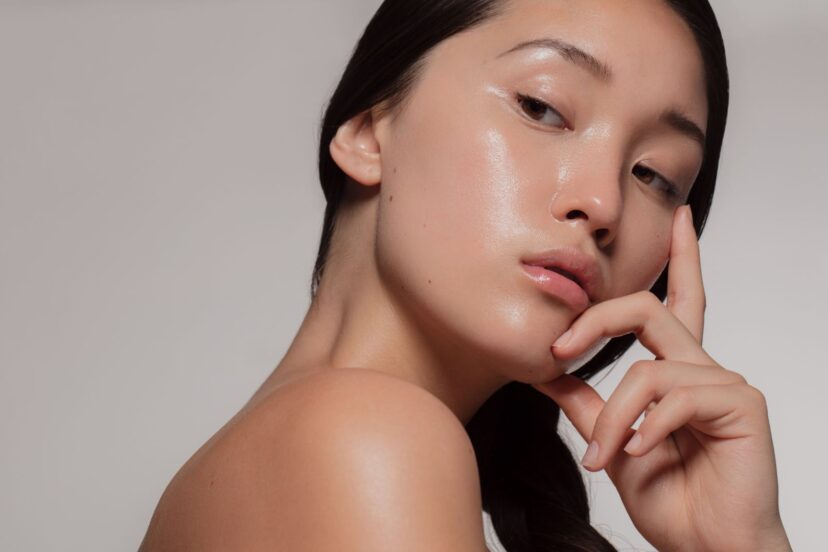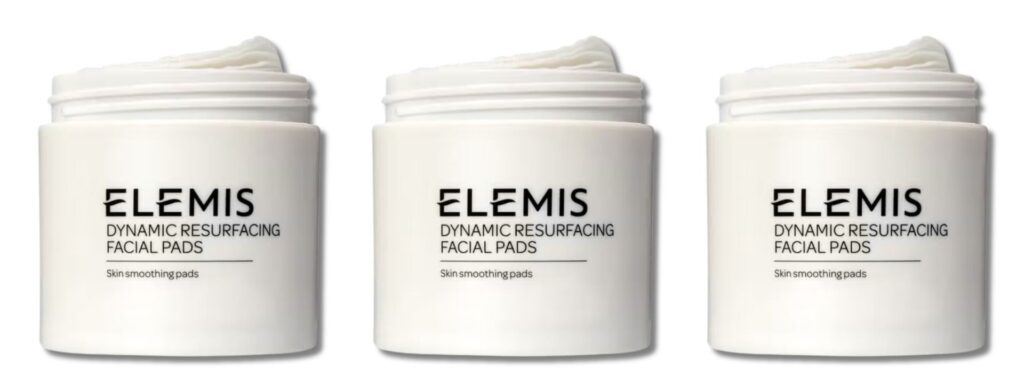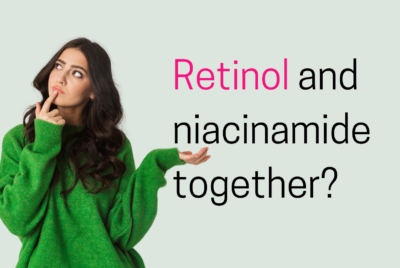Dynamic Resurfacing Facial Pads by Elemis: My Experience
I love Elemis Resurfacing Pads because one of the main ingredients is lactic acid, an Alpha Hydroxy Acid (AHA) 💕
If you’re anything like me, you’ve probably heard about AHAs and lactic acid.
Still, maybe you’re not entirely sure why they’re so good for your skin, especially as we get a bit older and start noticing those pesky fine lines and uneven texture.
Let’s dive in and demystify these ingredients so you can understand why these pads are worth the hype.
What are AHAs?
Alpha Hydroxy Acids, or AHAs, are a family of acids derived from fruits, milk, and sugar.
They’re gentle yet effective, particularly for those of us who want to maintain a youthful glow without resorting to drastic measures… Okay, I’ve been considering MesoBotox recently, but that’s for another article. I will definitely keep you posted, my dear reader.
AHAs work primarily by exfoliating the skin. But don’t picture the harsh scrubbing of a loofah; think of it as a gentle sweep, like removing the veil off a masterpiece, revealing the fresh, smooth skin underneath.
The magic lies in their ability to break down the bonds between dead skin cells, encouraging them to shed more quickly.
This process is key because it promotes cell turnover, which slows down as we age. And when we say cell turnover, we’re talking about your skin’s natural ability to renew itself. Think of it as spring cleaning for your face.
What is Lactic Acid, and Where Does it Come From?
Lactic acid, a member of the AHA family, is derived from milk, specifically from sour milk or fermented vegetables.
Picture Cleopatra soaking in her famed milk baths—lactic acid was her secret weapon for maintaining her legendary smooth skin.
Lactic acid is a gentle exfoliant. It’s milder than other AHAs, like glycolic acid, making it perfect for sensitive skin types or anyone new to acid exfoliation.
Its larger molecular size means it doesn’t penetrate as deeply, which reduces the likelihood of irritation while still delivering visible results.
The Benefits of Lactic Acid
So why exactly is lactic acid the darling of the skincare world?
For starters, it hydrates while it exfoliates. Unlike other acids that can leave your skin feeling parched, lactic acid attracts moisture to the skin. Think of it as exfoliation with a side of hydration, like having your cake and eating it too.
Lactic acid also helps to brighten the skin.
Over time, our skin can become dull due to dead skin buildup, environmental factors, and the natural aging process.
Lactic acid helps to slough off these dead cells, revealing the fresher, more radiant skin beneath. Studies have shown that regular use of lactic acid can even out skin tone and reduce the appearance of hyperpigmentation.
Who Benefits the Most from Lactic Acid?
Lactic acid is a bit of a chameleon – it adapts to various skin types and needs.
If you have dry skin, lactic acid’s moisturizing properties will be your best friend.
Whether you’re dealing with dullness or uneven texture, lactic acid can help brighten and smooth your complexion. And if you have sensitive skin, rest assured, it is gentle enough to exfoliate without causing irritation.
Women in their 30s and beyond will find lactic acid especially beneficial. As our skin ages, it naturally becomes drier and cell turnover slows down.
Other ingredients I love in Elemis Pads
1. Lactococcus Ferment Lysate
What is Lactococcus Ferment Lysate?
Lactococcus Ferment Lysate is a probiotic-derived ingredient obtained through the fermentation of Lactococcus lactis, a type of beneficial bacteria commonly found in dairy products.
This ingredient has been gaining popularity in skincare for its ability to support the skin’s microbiome, the collection of microorganisms that play a critical role in maintaining healthy skin.
Where Do We Find It?
Lactococcus Ferment Lysate is typically found in skincare products that strengthen the skin barrier, promote skin renewal, and improve overall skin health. It’s also a common ingredient in products aimed at sensitive or compromised skin.
How Does it Act on the Skin?
Lactococcus Ferment Lysate works by enhancing the skin’s natural renewal processes. It strengthens the skin barrier, making it more resilient against environmental stressors like pollution and UV radiation.
This ingredient also promotes cellular renewal, helping to maintain smooth, youthful-looking skin.
5 Main Benefits of Lactococcus Ferment Lysate:
- Strengthens the Skin Barrier: Helps protect the skin from external aggressors and maintain moisture.
- Promotes Skin Renewal: Encourages the natural shedding of dead skin cells, revealing fresher skin beneath.
- Supports the Skin Microbiome: Balances the skin’s natural flora, which is crucial for overall skin health.
- Reduces Sensitivity: Helps to calm and soothe irritated skin, making it ideal for those with sensitive skin.
- Improves Skin Texture: Contributes to a smoother, more refined skin texture by boosting cell turnover.
- Skin Type That Benefits the Most: Lactococcus Ferment Lysate is particularly beneficial for sensitive, reactive, or compromised skin. It’s also great for anyone looking to strengthen their skin barrier and improve overall skin health.
2. Saponaria Officinalis Leaf Extract
What is Saponaria Officinalis Leaf Extract?
Saponaria Officinalis, also known as soapwort, is a flowering plant that has been used for centuries for its natural cleansing properties. Its leaf extract contains saponins, natural compounds known for their gentle cleansing and soothing effects on the skin.
Where Do We Find It?
This ingredient is often found in gentle cleansers, toners, and products designed for sensitive skin. Its natural foaming properties make it a popular choice in products that aim to cleanse without stripping the skin of its natural oils.
How Does it Act on the Skin?
Saponaria Officinalis Leaf Extract is a gentle cleanser that purifies the skin without irritating. It’s also known for its anti-inflammatory properties, which help to calm and soothe the skin, making it ideal for sensitive or irritated skin.
5 Main Benefits of Saponaria Officinalis Leaf Extract:
- Gentle Cleansing: Removes dirt, oil, and impurities without stripping the skin.
- Soothing: Calms irritated or inflamed skin, reducing redness and discomfort.
- Anti-inflammatory: Reduces swelling and irritation, great for sensitive skin.
- Antioxidant Protection: Provides a mild antioxidant effect, protects against environmental damage.
- Hydrating: Helps to maintain the skin’s moisture balance, preventing dryness.
- Skin Type That Benefits the Most: Saponaria Officinalis Leaf Extract is especially beneficial for sensitive and dry skin types due to its gentle, soothing, and hydrating properties.
3. Subtilisin
What is Subtilisin?
Subtilisin is a type of protease enzyme, originally derived from the bacterium Bacillus subtilis. In skincare, it is used as an enzymatic exfoliant, helping to break down proteins in dead skin cells, which makes it easier for them to be sloughed off the skin’s surface.
[A protease enzyme breaks down proteins into smaller peptides or amino acids by cleaving the peptide bonds between them, so you know!]
Where Do We Find It?
Subtilisin is typically found in exfoliating products, including facial pads, masks, and peels. It is a key ingredient in formulations designed to smooth the skin’s surface and enhance cell turnover without the need for harsh physical exfoliation.
How Does it Act on the Skin?
Subtilisin works by breaking down the keratin proteins in dead skin cells, allowing them to be gently removed from the skin’s surface.
This enzymatic action is less abrasive than physical exfoliants, making it ideal for those with sensitive or aging skin.
5 Main Benefits of Subtilisin:
- Enzymatic Exfoliation: Gently removes dead skin cells, promoting a smoother skin texture.
- Reduces Fine Lines: Helps to diminish the appearance of fine lines by encouraging cell turnover.
- Brightens Skin: Reveals a more radiant complexion by removing dull, dead skin cells.
- Improves Product Absorption: Enhances the penetration of other skincare products by removing the barrier of dead cells.
- Gentle on Skin: Provides effective exfoliation without the irritation associated with physical exfoliants.
- Skin Type That Benefits the Most: Subtilisin is particularly beneficial for mature, sensitive, and dull skin types. Its gentle exfoliating action makes it suitable for those who need to improve skin texture and brightness without irritation.
What is Resurfacing, and How Does it Work?
Skin resurfacing is essentially a deep exfoliation process that improves skin texture, tone, and overall appearance. It’s like a facial reboot, removing the old, damaged layers of skin to reveal the newer, healthier layers beneath.
When we talk about resurfacing in the context of these Elemis pads, we’re talking about a controlled exfoliation process that helps to reduce the appearance of fine lines, wrinkles, and dark spots.
The lactic acid in these pads gently exfoliates, while other ingredients, like peptides and antioxidants, protect and nourish the skin.
The Main Benefits of Skin Resurfacing for Women 30+
Believe me!!!! skin resurfacing can be a game-changer. Not only does it help to keep your complexion smooth and even, but it also addresses some of the most common concerns we face as we age:
Fine Lines and Wrinkles:Regular resurfacing helps to smooth out these lines by promoting collagen production and encouraging cell turnover.
Hyperpigmentation: Sunspots and age spots are no match for regular resurfacing, which can help to fade these marks over time.
Dullness: By removing dead skin cells, resurfacing reveals the brighter, more radiant skin underneath.
Skin Texture: If you have uneven skin texture, resurfacing can help smooth things out, making your skin feel like a baby’s.
The Routine of Skin Resurfacing: When and How to Use the Pads
So, when should you use these magic pads? The best time to incorporate them into your routine is after cleansing but before moisturizing. Here’s a simple routine to follow:
Cleanse: Start with a gentle cleanser to remove makeup, dirt, and oils. Avoid harsh surfactants in cleansers and soaps!
Pad Application: Gently swipe the Elemis pad across your face. I do not avoid the eye area, and I have no problem at all. The lactic acid will get to work, exfoliating and prepping your skin for the next steps.
Serum: After using the pad, apply a hydrating serum to lock in moisture.
Moisturize: Finish with a nourishing moisturizer to seal in all the goodness.
Use these pads 2-3 times a week, especially if you’re new to exfoliation, to give your skin time to adjust.
FAQs
Can I use these pads if I have sensitive skin?
Yes! Lactic acid is one of the gentler AHAs, making these pads suitable for sensitive skin. Just start slow and see how your skin responds.
Should I use these pads in the morning or at night?
It’s best to use them at night to allow your skin to renew itself as you sleep. Plus, AHAs can make your skin more sensitive to the sun, so nighttime use reduces the risk of sun damage. That being saif since I work from home sometimes I use them in my AM routine 🤷♀️
Can I use these pads with retinol?
It’s best not to use them on the same night. Both are potent ingredients and using them together might be too harsh. Alternate nights or consult with your dermatologist.
How soon will I see the results?
Some people notice smoother skin after just a few uses, but for best results, consistency is key. You’ll likely see significant improvements in texture and tone after a few weeks.
Do I still need to use sunscreen?
Absolutely! Resurfacing can make your skin more susceptible to sunburn, so daily sunscreen use is non-negotiable.
There you have it! You can now feel confident and educated the next time you incorporate this gem into your skincare routine.
I appreciate you taking the time to reading this. May you be abundantly blessed in all your endeavors and crazy ideas you’re working on.
Disclaimer: Some of the links are affiliate links. I get a commission with your purchase. Thank you for supporting my blog 🙏







